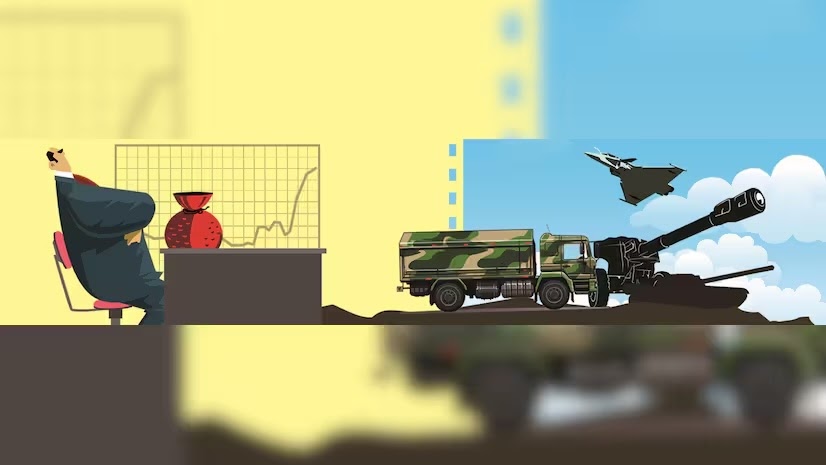
India remains the world’s largest defence buyer, importing 50 per cent of its defence needs
By Vikas Gupta
Defence News of India, 4th Oct 2024
Ministry of Defence (MoD) data indicates that India’s defence exports reached a record Rs 22,000 crore (US $2.63 billion) in 2023-2024. This amounts to a startling 31-fold growth over the past decade since 2013-14. Exports growth is showing no signs of diminishing either. Rather, exports have risen 32.5 per cent over the previous financial year (2022-2023). And in the first quarter of 2024-2025, defence exports surged to Rs 6,915 crore – a 78 per cent increase over the Rs 3,885 crore exported in the same period the previous year.
Last Monday, defence exports got another boost. An Indian private defence manufacturer, Tata Advanced Systems Limited (TASL) announced an agreement with Morocco’s Royal Armed Forces for assembling armoured troop carriers – referred to as wheeled armoured platforms, or WhaP 8×8 – in a new manufacturing unit in Casablanca, Morocco. This will be the first defence manufacturing plant established outside India by an Indian defence original equipment manufacturer (OEM) and Morocco’s first large defence manufacturing plant. Given the WhaP’s size, protection, versatility and affordability, it is expected to present an attractive buy for African militaries that are combating insurgencies. TASL regards Morocco as a launch customer for cracking the African arms bazaar.
The sharp uptick in India’s defence exports is due partly to our migration up the valuation ladder. As recently as a decade ago, India’s defence exports consisted mainly of low-cost ammunition and weaponry. Today, New Delhi is pursuing the sale of high value weapons platforms, such as the Tejas light fighter aircraft, Pinaka multi-barrel rocket launchers and even the sophisticated BrahMos surface-to-surface cruise missile, to East Asian customers such as Vietnam, Malaysia and the Philippines. The sale of one unit of BrahMos is estimated to be worth about $365 million – approximately the same as an entire year’s defence export sales a decade ago.
The need for boosting defence exports stemmed from simple mathematics: In the MoD’s Defence Production Policy of 2018 (DProP 2018), then defence minister Nirmala Sitharaman proposed creating employment for 2-3 million workers by 2025, by achieving an annual turnover of Rs 1,70,000 crore (US$ 20 billion) in defence and aerospace goods and services. This involved an additional investment of almost Rs 70,000 crores (US$ 8.3 billion approx). According to DProP 2018 however, India’s defence production only increased from Rs 43,746 crores in 2013-14 to Rs. 55,894 crores in 2016-17. Achieving the DProP’s ambitious targets required foreign buyers for Rs 35,000 crore worth of exports. This meant reducing our current dependence on imports and achieving self-reliance in developing and manufacturing key weapon systems/platforms latest by 2025: including fighter aircraft, medium lift, attack and utility helicopters, warships, land combat vehicles, autonomous weapon systems, missile systems, gun systems, small arms, ammunition and explosives, surveillance systems, electronic warfare (EW) systems, communication systems, night fighting enablers, submersibles, unmanned aerial vehicles (UAVs), training equipment and simulators.
However, seven years later, India remains the world’s largest defence buyer, importing 50 per cent of its defence needs, while struggling to meet defence export targets. Achieving these targets is not beyond the capabilities of Indian industry. However, four steps are essential for catalysing the changes needed.
First, while initial success has been achieved in exporting defence platforms that have been designed, manufactured and serviced in India, these are only preliminary measures. There is an urgent need to introduce these platforms into service in our own military, where it will mature and gradually demonstrate its capability. When a new platform performs well or demonstrates an unusually high capability, a media team should track the platform, record its achievements and ensure it is brought to the notice of prospective buyers. Only after building a track record in the service of its home country is a weapons platform likely to be taken seriously by any prospective buyer.
Second, an equipment or platform that is at an advanced stage of development and is close to being introduced into service must be allowed to complete its evaluation with realistic qualitative requirements (QRs). The Arjun tank and the Tejas fighter are examples of indigenous platforms that kept getting additional demands from the user (the military). Initially, the Defence Research and Development Organisation (DRDO) kept modifying the Arjun but, with no apparent end to the changes being demanded, the tank eventually collapsed under the weight of its own expectations. India’s military has hopefully learned the important lesson that the perfect is often the enemy of the good. Our army is infamous for putting out extreme QRs that demand more from the platform than will ever be asked for on an actual battlefield. This only results in development agencies, such as the DRDO or the Directorate of Warship Design, making endless changes and improvements that result in the product modifying itself into extinction.
A third lesson is that defence exports are essentially commercial devices that must serve the purpose of lowering the cost of a product or platform for the buyer and raising it for the seller. A government that is making a major arms sale must treat it like a “full court press”: a basketball phrase that refers to a strategy when every member of a team is driving directly for the opponent’s hoop, usually because time is running out and there is no place for fancy dribbling or footwork. In an arms sale, a full-court press would have the soldiers, the bureaucrats, the diplomats, the economists, the technocrats and even the media, all focused on winning an order to lower costs.
A fourth and final lesson is the need to structure defence acquisition agencies so as to maximise gains and minimise delays. Major defence exporters like the US have a dedicated department – called the Office of Defense Cooperation (ODC) – to oversee weapons sales and distribute responsibilities. This has resulted in a “munitions list” to tighten controls; while a standard operating procedure (SOP) has been promulgated for export controls. However, other than a small cell in the Department of Defence Promotion, we have no agency specifically charged with all export-related functions.
Such a department would provide institutional expertise in dealing with issues such as end-user certification and the complex permissions needed to sell an aircraft (like the Tejas) that has systems and sub-systems from various countries. For example, permissions would be needed to transfer an airborne radar from Israel, an ejection seat from the UK and a glass cockpit from France. The manufacture of Russian engines comes cwith their own delays. An institution to handle these procedures should be an immediate priority.
[END]






